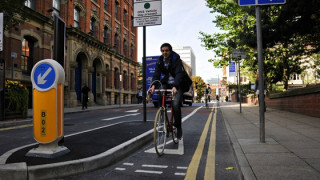The Department for Transport has released looking at increasing the speed limits on single carriageways for the lorries over 7.5 tonnes.
Despite Roads Minister Stephen Hammond earlier this month having reassured British Cycling that cycling is at the heart of transport policy, the consultation and impact assessment have no mention of cycling at all.
"HGVs have got wider and longer since the current limits were introduced and traffic is denser. We believe that the potential increased danger posed to cyclists should have been clearly and specifically addressed by the Department for Transport."
Martin Gibbs
This follows the introduction in 2011 of longer semi-articulated lorry trailers despite widespread concern about the increased road safety risks, again without any consideration of the implications for cycling.
Martin Gibbs, Policy & Legal Affairs Director, said: “If the Government is serious about putting cycling at the heart of transport policy it must look specifically at the consequences policy changes like this would have for cyclists. The impact assessment circulated with the consultation fails to even mention cycling.”
“We know that vehicle speed is the most significant determinant of road danger for cyclists and these speed limits were established for good safety reasons. On a single carriageway it can be difficult for an HGV to pull round someone on a bike, particularly if there is oncoming traffic. HGVs have got wider and longer since the current limits were introduced and traffic is denser. We believe that the potential increased danger posed to cyclists should have been clearly and specifically addressed by the Department for Transport.”
In contrast, however, some freight and construction organisations are paving the way in best practice on HGV safety in particular, Crossrail and the Mineral Products Association. The cycle safety element of Crossrail’s developments in London have been so successful that Transport for London have now adopted similar measures for all their procurement contracts and Crossrail is now advising London Boroughs on how to adapt their tendering processes.
The Mineral Products Association, which represents 465 companies involved in transporting minerals, primarily in the building sector is also taking safety seriously. It requires all its members to ensure their drivers have cycle safety specific training; fit additional mirrors, sidebars, audible warning systems, sensors and cameras to increase visibility in blind spots and warn cyclists that they might be in them, and campaigning for driver training on vulnerable road users to be a mandatory part of the Certificate of Professional Competence which every lorry driver needs, and are engaging in the exchanging places programme so that their drivers can try riding bikes on the roads and cyclists can see what it’s like to be in a cab.
It’s not only freight companies which are taking cycling seriously. The President of the AA, has called for cars and bikes to share the space on the road and break down the tribal mentalities. Edmund King calls for a culture change and welcomes more cyclists on the roads.
These are all good developments but it is the Department for Transport which should be showing leadership on cycling by making sure that all new policies are cycle friendly
We will be responding to the consultation raising our concerns for cycle safety, however, anyone can respond, so we call on all our members to submit their own responses or write to their MPs expressing their concerns about the policy.





